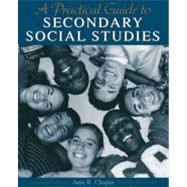
Every chapter concludes with “Summary,” “References,” and “Web Sites.”
1. Middle and Secondary Social Studies.
Why Become a Social Studies Teacher?
What Should Be Taught? Control of Standards to the States.
What Is Social Studies? A Single Subject Discipline?
Why Should Social Studies Be Taught? Goals of Civic Education.
What Social Studies Content Should Be Taught?
Tradition and Textbooks in Grade Placement Content.
Should Values and Character Education Be Taught?
2. Planning for Social Studies.
Planning.
Long-Range Planning.
Instructional Objectives and Specific Standards.
Organizing Content and Skills into Units.
Lesson Plans.
Block Scheduling.
3. Basic Instructional Methods.
The Need for Variety.
What Happens in Real Classrooms?
Teacher Lectures.
Direct Teaching or Direct Instruction.
Whole Class Discussions.
Questioning.
Independent Projects.
4. Active Student-Centered Strategies.
Cooperative Learning.
Jigsaw II.
Group Projects.
Co-op and Group Investigations.
Other Formats for Small Groups.
Inquiry and Problem-Based Learning.
Role Playing and Simulations.
5. Assessment and Evaluation.
Perceptions of Evaluation.
NAEO and State Tests.
Assessing Student Learning.
Teacher-Made Paper and Pencil Tests.
Performance-Based Assessment.
Grades and Report Cards.
6. Teaching History.
The Predominance of History in the Social Studies Curriculum.
Controversies on What History Should Be Taught.
Methods and Resources for Historical Understandings.
Methods and Resources for Historical Thinking Skills.
7. Teaching Geography, Economics, and the Behavioral Sciences.
The Status of Geography in the Schools.
Geography Standards and the Teaching of Geography.
The Status of Economics in the Schools.
National Economics Frameworks and Standards.
The Teaching of Economics.
Behavioral Sciences: Psychology, Sociology and Anthropology.
8. Teaching Civic Education and Global Education.
Civics Standards.
NAEP 1998 Civics Report Card.
IEA Civic Knowledge and Engagement at Age Fourteen.
Improving Civic Education in the Classroom and School.
The Community: Local Government and Service Learning.
Global Education and Multicultural/Diversity Education.
9. Technology and Professional Growth.
Technology Issues and Challenges.
Student Computer Standards.
The Computer as a Productivity Tool: Word Processing.
Using the Internet: E-Mail and the World Wide Web.
Locating and Evaluating Resources.
Other Uses of Computers.
Professional Growth.
The New copy of this book will include any supplemental materials advertised. Please check the title of the book to determine if it should include any access cards, study guides, lab manuals, CDs, etc.
The Used, Rental and eBook copies of this book are not guaranteed to include any supplemental materials. Typically, only the book itself is included. This is true even if the title states it includes any access cards, study guides, lab manuals, CDs, etc.